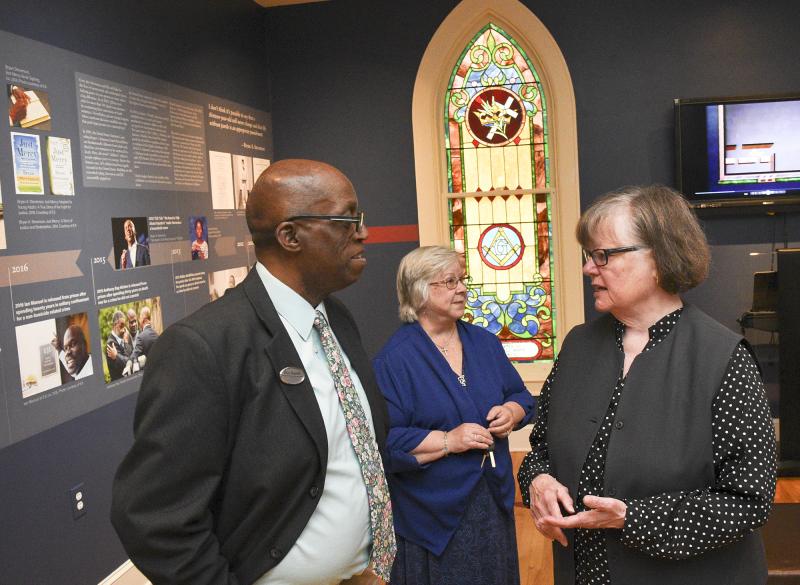Editor’s note: This story has been updated to correct the name of Jay Diaz and Katie Green’s printing company, Print Coast 2 Coast.
Visitors to the Lydia Cannon Museum in Milton are now able to walk in the footsteps of a hometown hero. “Walking Into Greatness: Bryan Stevenson” is a multimedia showcase that traces the life of the Milton native, lawyer and equal justice advocate from birth to July 2018, when the town issued a proclamation recognizing Stevenson’s accomplishments.
The exhibit, which opened May 25, documents Stevenson’s life, starting with his family origins and his birth in Milton. Visitors walk through the exhibit following footprints, which start as tiny baby prints and grow larger as Stevenson grows up. Throughout the exhibit, images of Stevenson’s life are juxtaposed with photos from the Civil Rights movement and the history of the death penalty in the United States, threads that weave together with his life experience as he grows up.
Until second grade, Stevenson attended a segregated, all-black elementary school on Route 16. Stevenson was part of desegregating classes at Milton Elementary and junior high schools before going to Cape Henlopen High School, where he played both soccer and baseball and served as student body president before graduating in 1977. He was named Best All-Around in the student yearbook. After graduating from Eastern University in Philadelphia, Stevenson was awarded a scholarship to attend Harvard Law School and soon began working on behalf of death row inmates in the South.
The exhibit details the founding of the Equal Justice Initiative in Montgomery, Ala., which began as a means to provide legal assistance to prisoners who were poor or wrongly convicted, and went on to represent death row prisoners. Among his famous cases are overturning the sentences of children facing the death penalty or life in prison.
In the center of the exhibit is a judge’s bench, which museum curator Heidi Nasstrom Evans said will allow student visitors to role-play the case of Kuntrell Jackson, in which the U.S. Supreme Court ruled that it was unconstitutional to give mandatory life sentences to defendants who were less than 18 years old at the time of the crime.
The exhibit also offers a film about Stevenson that combines clips from two appearances on “60 Minutes,” and documentary footage, as well as excerpts from his 2012 TED Talk about how the justice system works against the poor and people of color. The film and the exhibit show his rise to national prominence, including his best-selling book, “Just Mercy,” an autobiography that documents his legal philosophy through the stories of people the Equal Justice Initiative has helped.
Stevenson’s most recent project is The Legacy Museum: From Enslavement Through Mass Incarceration, which opened in April 2018 and documents the history of slavery and racism in America.
For Nasstrom Evans, the exhibit was her first project after being brought on as curator in October. Her research included interviews with Stevenson’s family members, reading Stevenson’s writings, and interviews and trips to Montgomery to visit The Legacy Museum, founded by the Equal Justice Initiative. “I am so happy it turned out looking the way it did,” she said. “It’s a good show. I’m proud of it.”
Nasstrom Evans credited Lewes-based printer Jay Diaz Jr. and designer Katie Green of Print Coast 2 Coast for designing and installing the wall murals and creating the footprints.
While Stevenson himself was not interviewed for the project, Nasstrom Evans said he will see the exhibit during a private showing. In accordance with Stevenson’s wishes for privacy, she declined to provide the date, but said students from area schools would be hand-picked to take part in the showing. “I think it will be fun for him to look at it,” she said. “I want to see his reaction to everything.”
Milton Mayor Ted Kanakos said of Stevenson, “What he’s done is just amazing. It brings out that this is a wonderful little town.” Kanakos said he hopes he can convince Stevenson to come to Milton in the fall to receive a key to the city.
The Stevenson family, including Bryan’s sister, Christy Taylor, and his cousin, Alonna Berry, toured the exhibit privately May 20 before it opened. Taylor and Berry worked on planning, along with Nasstrom Evans and former Director Lee Revis-Plank.
The exhibit’s opening was emotional for Revis-Plank, who served as interim director until December, when Mary Knight was hired for the permanent role. She said, “I looked for the opportunity to find a hometown hero, and Bryan is a hometown hero. It’s an opportunity to be much more inclusive in what we display as far as Milton history.” Revis-Plank said she wanted the exhibit to inspire children in the Cape school district to see greatness in themselves through Stevenson.
Knight said, “It was a labor of love. For an exhibit of this magnitude to be in a small town like Milton is incredible.”
Marie Mayor, Milton Historical Society board of trustees chairwoman said, “I think this is a wonderful opportunity for people in Milton to celebrate someone so distinguished.”
Berry, who is working on establishing a charter school in Sussex County, called the Bryan Allen Stevenson School of Excellence, said the project was six months of love in the making. “To stand in the space that reflects the history of our community, and what it meant to be a person of color growing up in this community, is a powerful story that I don’t think we’ve told enough. I’m happy the Milton Historical Society decided to take this on and display it the way that they did,” Berry said.
She said the goal of the exhibit was to try to bring Stevenson’s voice and perspective into the space and to make it friendly for children, to show them that someone like them came from their community and attained such prominence. “I think it’s a well-thought-out and strong story being told.”

























































